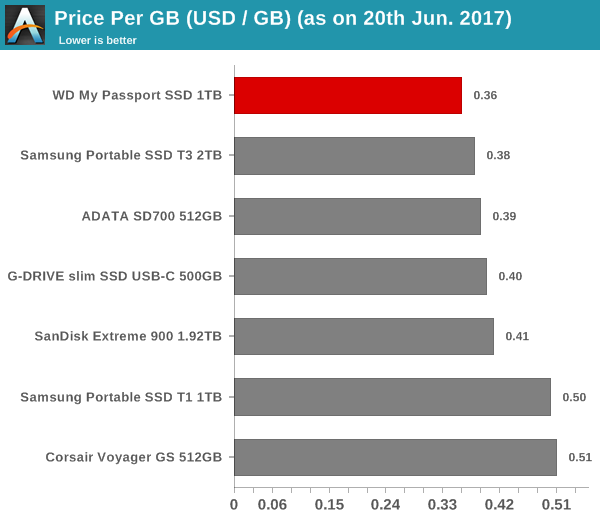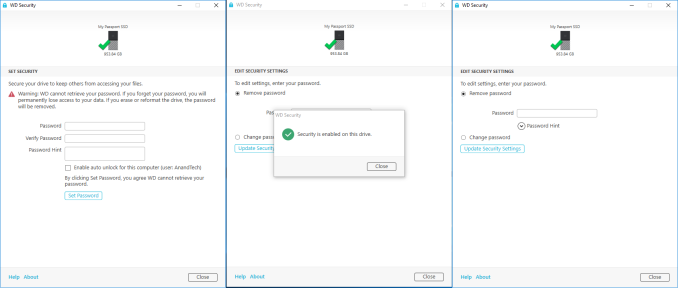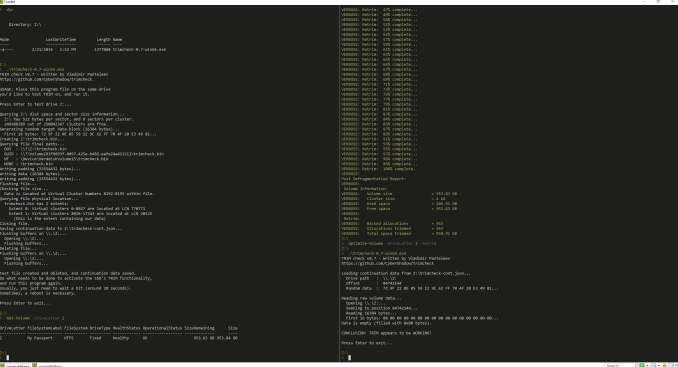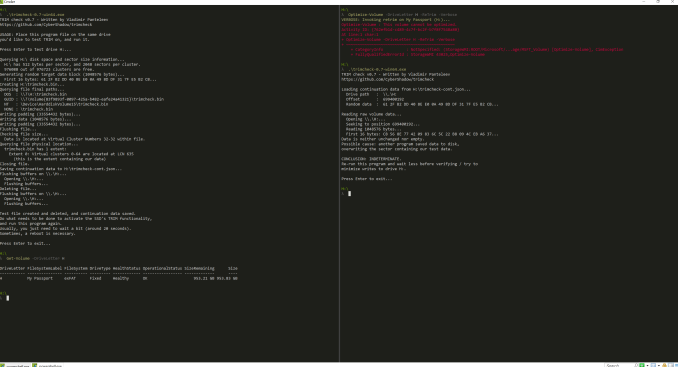Western Digital My Passport SSD Mini-Review
by Ganesh T S on June 28, 2017 8:00 AM EST- Posted in
- Storage
- SSDs
- Western Digital
- DAS
- USB 3.1
Miscellaneous Aspects and Concluding Remarks
The My Passport SSD targets the mainstream market, and its performance in the benchmarks is understandable. However, there are a few things in its favor - the value additions such as hardware encryption and backup software from WD, as well as the price. Before discussing the pros and cons, it is important to check out some other relevant aspects of the product.
USB Host and Encryption Impacts
Our tests above show that we were never able to hit WD's claimed 500 MBps+ numbers even in the artificial benchmarks. In order to identify whether the USB 3.1 Gen 2 host in our testbed (the Intel Alpine Ridge controller) had any negative impact on the device, we processed CrystalDiskMark using one of the USB 3.1 Gen 2 Type-C ports in the Zotac CI523 nano. The USB 3.1 Type-C ports in that PC are enabled by an ASMedia ASM1142 controller.
The above numbers are definitely a step up from what we got with our testbed's USB 3.1 Gen 2 port, indicating that the My Passport SSD is likely to perform better with USB 3.1 Gen 2 ports from an ASMedia controller (between 25 - 35 MBps for sequential workloads, and a significant improvement in write IOPS for random workloads).
We also used this opportunity to test the impact of enabling the TCG Opal 2.0 features of the SSD using the WD Security software. A password is used to protect the contents of the drive, and the software is very simple to use (geared towards the mainstream consumer). The picture below presents some screenshots from the WD Security software.
The CrystalDiskMark workloads were processed on a password protected drive.
Comparing the numbers with the 'no encryption' case above shows that enabling the hardware encryption has almost no discernible impact on the performance. The numbers for both cases are within the run-to-run variations that one usually expects from CrystalDiskMark.
TRIM Support
SanDisk has never enabled TRIM on any of its external SSDs till now. The WD My Passport SSD finally sees a change. The bridge chip is able to map the SCSI Unmap commands to TRIM, as our test below shows. Note that the SSD had to be formatted in NTFS for the manual TRIM command to work.
Triggering a manual TRIM on an exFAT-formatted SSD returned an indeterminate status.
Concluding Remarks
The My Passport SSD completes the efforts of Western Digital to segment the external SSD market segment and divide it up between its three different brands - WD, SanDisk, and G-Technology.
The performance of the My Passport SSD is good enough for the mainstream market, though power users might be disappointed. Western Digital needs to pay more attention to the thermal design for performance consistency. UASP also needs to be enabled in the firmware for the unit to match the performance of similar external SSDs in the market. Western Digital indicated that UASP could be enabled in future production runs, but, no concrete timeframe was provided.
TRIM support makes the My Passport SSD a great choice for a portable OS drive. The product is based on the SanDisk X400 TLC SSD, and this allows for an attractive price point. The MSRP is $400 for the 1TB variant, but, we have seen the Best Buy price fluctuate between $350 and $400 during the time that we tracked it.

The M.2 version of the SanDisk 1TB X400 has a street price of around $330. A M.2 to USB 3.1 Gen 2 enclosure (such as the StarTech SM21BMU31C3) has a street price of $32. The My Passport SSD has a better industrial design, a few software value additions for backup, and also has hardware encryption (not available in the retail M.2 version of the X400). Given the $350 - $400 price range for the My Passport SSD, it is a toss-up between the two options. Mainstream consumers want a plug and play solution, and that gives the My Passport SSD a slight edge in its target market.















22 Comments
View All Comments
bignazpwns - Saturday, July 15, 2017 - link
It's a nice drive. The black plastic feels and looks cheap but one screw is all it takes to crack it open. Uses a m.2 drive that's just 2 sided taped down. Easy to pop out and put it in a Mobo's m.2 slot and 550/540 so not to bad. The issue is with the controller on the m.2 to USB interface. But on sale this is a nice source or a cheap 1tb m.2 drive. I'll check the USB to m.2 board with a NVME drive to see how much it slows that down. But it's a nice drive and is much better then the Samsung that uses a junk msata drive and the SanDisk that uses. Normal sata drive in a small enclosure. And I will confirm the drive in the WD is a SanDisk and works in a Mobo m.2 slot without doing anything extra. And for those why want to do the swap. There are 2 small 2 sided tape squaresNathanks - Tuesday, July 10, 2018 - link
Can you do the review again with current intel 8th gen board with usb 3.1 gen -2 i believe old board is limited to gen 1. which is 5gbps